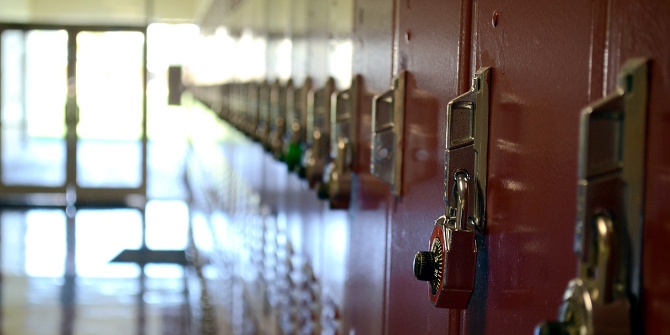
 Classroom engagement is an important influence on how well students perform academically at school. In new research, Carolyn Côté-Lussier and Caroline Fitzpatrick find that how students engage in class can be affected by their environment – students who reported that they felt safer were more engaged . They write that teens might feel unsafe at school because of poverty at home, and if their school has a poor neighbourhood environment, such as a lack of green spaces.
Classroom engagement is an important influence on how well students perform academically at school. In new research, Carolyn Côté-Lussier and Caroline Fitzpatrick find that how students engage in class can be affected by their environment – students who reported that they felt safer were more engaged . They write that teens might feel unsafe at school because of poverty at home, and if their school has a poor neighbourhood environment, such as a lack of green spaces.
Youth who fail to finish high school begin their adult life at a huge disadvantage. They earn lower salaries, remain unemployed for longer, and engage in more lifestyle and health risks. Sadly, high school dropout rates remain high, with about one in ten students dropping out, in many industrialised nations including Canada, the United States, and England.
Students that are disengaged in the classroom are especially at-risk of quitting school before obtaining their diploma. Engagement in learning is the ability to follow directions, work autonomously, and pay attention to teacher instructions. There is consensus that engagement can have a strong influence on the direction a student’s academic trajectory will take. Engaged students obtain good grades, get along well with teachers and peers, and tend to harbor positive self-concepts. In contrast, disengaged students, fall behind their colleagues academically, report more conflict with teachers and peers, and tend to develop more problem behaviors.
How can we increase engagement in students? Research has found that some of the ingredients that promote engagement are present in students well before they begin high school. Nevertheless, as our new research suggests, the immediate environment or context in which students find themselves also matters. We found that students who reported feeling safer were rated as more engaged by their teachers at the end of their first year of high school. The study was conducted with more than 2,000 high school students who were followed in the Quebec Longitudinal Study of Child Development.
For some youth, feeling unsafe at school can have a negative impact on health and well-being. For example, feeling unsafe can lead to increased stress and emotional difficulties. For this reason we also considered whether students who felt less safe reported more symptoms of depression, such as feeling unhappy and having difficulty enjoying themselves. We also considered whether the association between feeling unsafe and poor engagement is partially explained by the experience of symptoms of depression. Our analyses indicated that students that felt unsafe tended to report being more depressed which appeared to interfere with their classroom engagement.

Credit: Brett Levin (Flickr, CC-BY-2.0)
We also attempted to examine why some youth felt safer than others. Being bullied or witnessing school violence only partly contributed to how safe students felt, suggesting other factors are involved. There are several reasons youth might feel unsafe at school. Students’ home neighbourhoods can influence how safe they feel both at home and at school. For example, we learned in a previous study that youth who experience chronic poverty or who live in more disadvantaged neighbourhoods tend to feel less safe at school. We have hypothesized this might be the case because students that live in disorderly, disadvantaged neighbourhoods “carry” their fears to school every day. Furthermore, the features of the physical environments in which schools are located are important. For example, the presence of green spaces and well maintained buildings are likely to make youth feel more at ease.
Our recent findings further strengthen the need for comprehensive intervention approaches for reducing high school underachievement and dropout. While promoting academic skills should remain a priority for school-based interventions, our work suggests that interventions can benefit from increased attention to improving the physical and psychological climate inside and surrounding schools. We believe that several policy solutions are feasible. For one, increased monitoring of student reactions and responses to incidences of bullying and violence, not only occurring in the school but also those reported in the media could be undertaken by teachers and school healthcare professionals. Second, through continued professional education, it is possible to increase teacher awareness of the importance of student feelings of safety as well as the wider school climate for improving engagement. Finally, parents, schools and communities can become advocates for wider environmental interventions that aim to improve the physical features of school and student neighbourhoods.
This article is based on the paper, ‘Feelings of Safety at School, Socioemotional Functioning, and Classroom Engagement’ in the Journal of Adolescent Health.
Please read our comments policy before commenting.
Note: This article gives the views of the author, and not the position of USApp– American Politics and Policy, nor of the London School of Economics.
Shortened URL for this post: http://bit.ly/1sgh73k
______________________
 Caroline Fitzpatrick – Université Sainte-Anne, Canada.
Caroline Fitzpatrick – Université Sainte-Anne, Canada.
Dr Caroline Fitzpatrick is an assistant professor at Sainte-Anne’s University of Nova Scotia where she teaches psychology and statistics. She is also an affiliate researcher at Concordia University’s PERFORM Center and an appointed research fellow at the University of Johannesburg, in the department of childhood education. Her work addresses the childhood origins of education and health inequities and has the ultimate goal of informing social policies and public health initiatives aimed at improving child physical and mental health internationally.
 Carolyn Côté-Lussier – University of Ottawa
Carolyn Côté-Lussier – University of Ottawa
Dr Carolyn Côté-Lussier, is an assistant professor of Criminology at the University of Ottawa. She is also part of the Spatial Health Research (SPHERE) lab (University of Montreal), dedicated to improving understanding of how environments contribute to population health profiles, and a senior researcher at the Centre for Research on Educational and Community Services (CRECS) (University of Ottawa). Her research intersects criminology, social psychology, and social and preventive medicine.













For sure kids need to feel safe in school before they can engage freely and exercise their creativity. Otherwise their self-confidence and self-esteem plummets, which would spell under-achievement. Thanks for this great article.